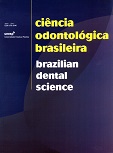Measuring polymerization shrinkage of composites utilizing a gas pycnometer
DOI:
https://doi.org/10.14295/bds.2003.v6i3.595Resumo
The objective of this laboratory study was to evaluate the volumetric contraction of five resin composites currently in use. A helium gas pycnometer was used to determine the volume of specimens prior to and after photopolymerization from which total volumetric contraction was obtained. The resin was weighed in an analytic balance and inserted into the pycnometer chamber, the volume of which is known, and hermetically sealed. The volume of the specimen was determined by measuring the pressure change of helium when it was opened up to the expansion chamber. In this study, 15 cycles of pressurizing were repeated for volume determination for each specimen. The arithmetic mean volume was obtained. The final volume was evaluated as done before. The percentage contraction (P) was calculated by: P = 100(SVi - SVf) / SVi, where SV is specific volume and the suffixes i and f indicate measurements before and after polymerization, respectively. The measured volumetric shrinkage ranged from 0.56% for Z250 (3M-ESPE) to 3.26% for P60 (3M-ESPE). The gas pycnometry is a promising method and its mechanism should be more explored for investigating dental materials.Downloads
Downloads
Publicado
Como Citar
Edição
Seção
Licença
TRANSFERÊNCIA DE DIREITOS AUTORAIS E DECLARAÇÃO DE RESPONSABILIDADE
Toda a propriedade de direitos autorais do artigo "____________________________________________________________________" é transferido do autor(es) para a CIÊNCIA ODONTOLÓGICA BRASILEIRA, no caso do trabalho ser publicado. O artigo não foi publicado em outro lugar e não foi submetido simultaneamente para publicação em outra revista.
Vimos por meio deste, atestar que trabalho é original e não apresenta dados manipulados, fraude ou plágio. Fizemos contribuição científica significativa para o estudo e estamos cientes dos dados apresentados e de acordo com a versão final do artigo. Assumimos total responsabilidade pelos aspectos éticos do estudo.
Este texto deve ser impresso e assinado por todos os autores. A versão digitalizada deverá ser apresentada como arquivo suplementar durante o processo de submissão.




























